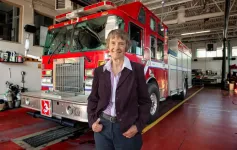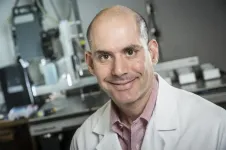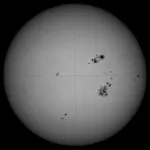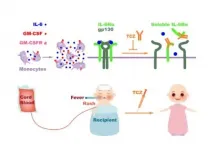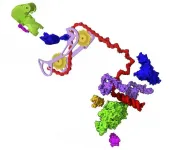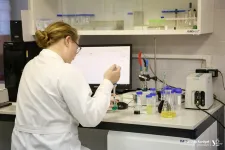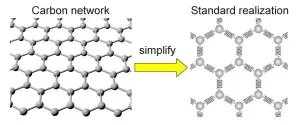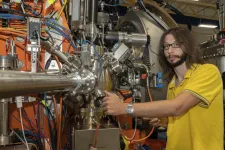(Press-News.org) (Edmonton, AB) Firefighters at the centre of the battle against the massive Fort McMurray wildfire in 2016 have persistent lung damage, according to new findings published by a University of Alberta occupational health research team.
"Those who were dealing with burning organic matter were exposed to a barrage of small particles in the smoke, and the ones with the highest exposure have long-term consequences," said principal investigator Nicola Cherry, an occupational epidemiologist, professor of medicine and Tripartite Chair of Occupational Health in the Faculty of Medicine & Dentistry.
The firefighters had more than double the risk of developing asthma compared with the general population. They also exhibited a number of changes in lung function tests supportive of an effect on the lungs, including greater lung hyperreactivity and increased thickening of the bronchial wall.
"The impact was correlated to exposure--those who had more exposure had more effects," said Cherry.
For three years after the fire, Cherry's team followed 1,234 Alberta firefighters.The firefighters' exposure to fire-related particles was estimated based on the hours they worked on the blaze, the dates they were there, the firefighting tasks they were performing, and Alberta Environment estimates of particulate matter at different locations.
The Fort McMurray fire broke out in May 2016 and was under control by the fall, but it was not officially declared out until the following year. The highest exposure to particulate matter happened during the first week, Cherry said. Firefighters were deployed from across Alberta from crews that specialize in structural fires (i.e., buildings), oil and gas industry fires and wildland fires.
Many did not have sufficient supplies of specialized lung protection equipment or were not able to wear it while fighting the Fort McMurray fire, Cherry said.
"It was an extraordinarily violent fire," she said. "It's very difficult to rush uphill pulling equipment behind you if you have a heavy mask on that doesn't let you breathe."
Cherry modelled her study, which was funded by the Canadian Institutes for Health Research and the Government of Alberta, on studies that examined the respiratory health of first responders following the World Trade Center collapse in New York City in September 2001.
"It's not easy to do this kind of study during a catastrophe," said Cherry, who had serendipitously taken delivery of a mobile lung assessment lab the week before the Fort McMurray fire broke out.
"At the World Trade Center, the exposure was mainly to inorganic dust, whereas in Fort McMurray it was burning vegetation, as well as buildings," Cherry said. "It's interesting that we saw similar results from very different exposure."
Cherry's research team looked at three main sources of evidence about the lung health of the firefighters before and after the fire. First, they asked for permission to link to their administrative health record, which showed doctor's visits and diagnoses. The records for each firefighter were matched with five patients from the general population of similar age, sex, geographic location and health status as a control group for comparison.
The team also measured the firefighters' lung function, which shows how much air goes in and out of the lungs. Finally, some of the firefighters with no history of chronic respiratory disease or smoking were randomly selected for clinical followup, including CT scans of their lungs and methacholine challenge testing, used to check for asthma.
This is one of several papers Cherry has published on the mental and physical health of the Fort McMurray firefighters.
"They take enormous risks," she said. "This study shows clearly that it is possible for exposures to cause changes in the lung that don't get better over time."
Cherry said she will continue to study the occupational health of firefighters--including crews currently fighting wildfires in the interior of British Columbia and Alberta--in hopes of recommending ways to make the work safer. She is studying whether wearing a mask or washing skin more often could reduce exposure to chemicals from smoke. Putting more crews through shorter rotations at fire scenes might also help to lessen health impacts, she said.
"We are trying to come up with clinical indicators that could be helpful to firefighters whose lungs have been damaged, such as the combination of bronchial reactivity and thickening that we see in this study," she said.
INFORMATION:
BIRMINGHAM, Ala. - An experimental drug reported in Nature Communications suggests that a "path is clearly achievable" to treat currently untreatable cases of cystic fibrosis disease caused by nonsense mutations. This includes about 11 percent of cystic fibrosis patients, as well as patients with other genetic diseases, including Duchenne muscular dystrophy, β-thalassemia and numerous types of cancers, that are also caused by nonsense mutations.
The drug is a small molecule with a novel mechanism of action, say David Bedwell, Ph.D., and Steven Rowe, M.D., MSPH, co-senior authors. Bedwell is professor and chair of the University of Alabama at Birmingham Department of Biochemistry and Molecular ...
Scientists from the University of Graz, Kanzelhöhe Observatory, Skoltech, and the World Data Center SILSO at the Royal Observatory of Belgium, have presented the Catalogue of Hemispheric Sunspot Numbers. It will enable more accurate predictions of the solar cycle and space weather, which can affect human-made infrastructure both on Earth and in orbit. The study came out in the Astronomy & Astrophysics journal, and the catalogue is available from SILSO -- the World Data Center for the production, preservation, and dissemination of the international sunspot number.
Our Sun is a big boiling ball of gas, most of which is so hot that electrons are ripped off from atoms, creating a circulating mix of charged particles, called plasma. These moving charges ...
A potentially life-saving treatment for heart attack victims has been discovered from a very unlikely source - the venom of one of the world's deadliest spiders.
A drug candidate developed from a molecule found in the venom of the Fraser Island (K'gari) funnel web spider can prevent damage caused by a heart attack and extend the life of donor hearts used for organ transplants.
The discovery was made by a team led by END ...
The research team led by Prof. WEI Haiming and Prof. TIAN Zhigang from Division of Life Sciences and Medicine, University of Science and Technology of China (USTC) of the Chinese Academy of Sciences (CAS), collaborating with the research group led by Prof. SUN Zimin from the First Affiliated Hospital of USTC revealed the pathological mechanism of severe pre-engraftment syndrome (PES) after umbilical cord blood transplantation, not only providing a treatment strategy for patients with PES, but significantly guiding for further improvement in the curative effect of unrelated cord blood transplantation (UCBT). This study was published in Nature Communications.
UCBT is an important means to cure hematological ...
In February 2020, a trio of bio-imaging experts were sitting amiably around a dinner table at a scientific conference in Washington, D.C., when the conversation shifted to what was then a worrying viral epidemic in China. Without foreseeing the global disaster to come, they wondered aloud how they might contribute.
Nearly a year and a half later, those three scientists and their many collaborators across three national laboratories have published a comprehensive study in Biophysical Journal that - alongside other recent, complementary studies of coronavirus proteins ...
Russian scientists have synthesized chemical compounds that can stop the degeneration of neurons in Alzheimer's, Parkinson's, and other severe brain pathologies. These substances can provide a breakthrough in the treatment of neurodegenerative pathologies. New molecules of pyrrolyl- and indolylazine classes activate intracellular mechanisms to combat one of the main causes of "aged" brain diseases - an excess of so-called amyloid structures that accumulate in the human brain with age. The essence of the study was published in the European Journal of Medicinal Chemistry. Experts from the Institute of Cytology of the Russian Academy of Sciences, the Institute of Organic Synthesis of the Ural Branch of the Russian ...
A new mathematical model helps predict the tiny changes in carbon-based materials that could yield interesting properties.
Scientists at Tohoku University and colleagues in Japan have developed a mathematical model that abstracts the key effects of changes to the geometries of carbon material and predicts its unique properties.
The details were published in the journal Carbon.
Scientists generally use mathematical models to predict the properties that might emerge when a material is changed in certain ways. Changing the geometry of three-dimensional (3D) graphene, which is made of networks of carbon atoms, by adding chemicals or introducing topological defects, can improve its catalytic properties, for example. But it has been difficult for scientists to understand why this happens exactly.
The ...
Researchers from the Paul Scherrer Institute PSI and the Brookhaven National Laboratory (BNL), working in an international team, have developed a new method for complex X-ray studies that will aid in better understanding so-called correlated metals. These materials could prove useful for practical applications in areas such as superconductivity, data processing, and quantum computers. Today the researchers present their work in the journal Physical Review X.
In substances such as silicon or aluminium, the mutual repulsion of electrons hardly affects the material properties. Not so with so-called correlated materials, in which the electrons interact strongly with one another. The movement of one electron in a correlated material leads ...
Prof. LI Chuanfeng, Prof. XU Jinshi and their colleagues from Prof. GUO Guangcan's group, University of Science and Technology of China (USTC) of the Chinese Academy of Sciences (CAS), realized the high-contrast readout and coherent manipulation of a single silicon carbide divacancy color center electron spin at room temperature for the first time in the world, in cooperation with Prof. Adam Gali, from the Wigner Research Centre for Physics in Hungary. This work was published in National Science Review on July 5, 2021.
Solid-state spin color centers are of utmost importance in many applications of quantum technologies, the outstanding one among which is the nitrogen-vacancy (NV) center in diamond. Since the detection ...
African swine fever (ASF), first detected in Germany in domestic pigs on 15 July 2021, does not pose a health hazard to humans. "The ASF pathogen cannot be transferred to humans", explains Professor Dr. Dr. Andreas Hensel, President of the German Federal Institute for Risk Assessment (BfR). "No risk to health is posed by direct contact with diseased animals or from eating food made from infected domestic pigs or wild boar".
The ASF pathogen is a virus which infects domestic pigs and wild boar and which leads to a severe, often lethal, disease in these animals. It is transferred via direct contact or with excretions from infected animals, or through ticks. The ASF virus is endemic to infected wild animals ...
